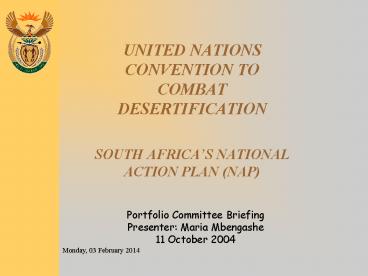UNITED NATIONS CONVENTION TO COMBAT DESERTIFICATION SOUTH AFRICA - PowerPoint PPT Presentation
Title:
UNITED NATIONS CONVENTION TO COMBAT DESERTIFICATION SOUTH AFRICA
Description:
6/21/09. UNITED NATIONS CONVENTION TO COMBAT DESERTIFICATION ... beautiful landscapes and productive ecosystems that sustain livelihoods and ... – PowerPoint PPT presentation
Number of Views:205
Avg rating:3.0/5.0
Title: UNITED NATIONS CONVENTION TO COMBAT DESERTIFICATION SOUTH AFRICA
1
UNITED NATIONS CONVENTION TO COMBAT
DESERTIFICATIONSOUTH AFRICAS NATIONAL ACTION
PLAN (NAP)
- Portfolio Committee Briefing
- Presenter Maria Mbengashe
- 11 October 2004
2
OVERVIEW
- Why National Action Program (NAP)?
- Objectives of UNCCD
- Desertification/land degradation- issues and
implications - Global and National legal frameworks
- NAP vision and objectives
- How NAP was developed
- Existing Programmes
- Progress made in the development of the NAP
- Plans for the next six months.
3
OBJECTIVES - NATIONAL ACTION PROGRAM (NAP)
UNCCD-Article 10
- Requirement of Convention to Combat
Desertification (UNCCD) - NAP- Long term integrated strategies focusing on
improved productivity of land aimed at - Prevention and/or reduction of land degradation
- Rehabilitation of degraded ecosystems e.g..
grasslands - Reclamation of desertified land
- Integrating strategies for poverty eradication
- Promote cooperation among departments, spheres of
govts, civil society and other MEAs - Mobilisation of funds and resources
4
OBJECTIVES OF UNCCD
- To combat desertification and mitigate the
effects of drought through effective action at
all levels, supported by international
cooperation and partnership arrangements, in the
framework of an integrated approach which is
consistent with Agenda 21, with a view to
contributing to the achievement of sustainable
development in affected areas.
5
DESERTIFICATION-ISSUES AND IMPLICATIONS
- Desertification is land degradation in arid,
semi-arid and dry sub-humid areas resulting from
erosion, deforestation, water scarcity, loss of
soil fertility overgrazing and climatic
variations - Land degradation is worldwide in geographic
extent and global in its environmental and socio
economic impacts. 91 of South Africa surface
area has arid, semi-arid or dry-subhumid climates - Drylands ecosystem have immense scientific,
economic and social value and are source of
livelihood to a quarter of earths population - Since 1990, 6 million hectares of productive land
has been lost every year due to land degradation - 14 African countries are subject to water
scarcity - Threatens the livelihoods of one billion people
and has already made 135 million people homeless - As a result of declining food security the number
of undernourished people in Africa doubled from
100m in 1960 to 200m in 1995 - Prevention and control of land degradation is
critical to achieving sustainable development
6
GLOBAL AND NATIONAL LEGAL FRAMEWORKS
- RIO CONVENTIONS CBD,UNCCD AND UNFCCC-
- Adopted in1997 United Nations Convention to
Combat Desertification in those Countries
experiencing serious drought and/or
desertification, particularly in Africa (the
UNCCD). South Africa ratified in 1997 - WSSD 2002 and Millennium Development Goals
- NEPAD- commitment of preventing land degradation
- NEMA-Biodiversity Act no 10 of 2004
- National Forest Act National Veld and Forest
Fire Act - National Water Act and Conservation of
Agricultural Resources Act (CARA)
7
NAP VISION
- Prosperous and healthy South Africans living in
an environment restored and maintained through
universal improvement in land management to its
beautiful landscapes and productive ecosystems
that sustain livelihoods and ecosystem services,
for the benefit of current and future generations.
8
NAP- PURPOSE
- To promote sustainable land management throughout
South Africa - Establish strategies and priorities to combat
desertification - Implementation of policies that affect natural
resource management and rural development - Partnerships between governments departments,
private sector, communities, civil society and
land owners - Strengthen implementation and collaboration among
existing program initiatives - Poverty alleviation, promotion of the enhancement
of sustainable livelihoods and sustainable land
management through land reform, community based
projects, rural finance human resource
development and awareness raising and education
9
DEVELOPMENT OF NAP
- South Africa has established institutional and
legal arrangements to meet its commitments in
terms of the UNCCD. - The Department of Environmental Affairs and
Tourism (DEAT) is the Focal Point for the
Convention. - A multi-stakeholder Steering Committee guides the
role as Focal Point for the UNCCD. - The SA-UNCCD Steering Committee has been the
principal coordinating mechanism since 1995,
prior to South Africas accession to the
Convention. - SA has involved relevant national and provincial
government departments, communities, NGOs,
academic institutions and private sector in the
development and implementation of the NAP
10
EXISTING PROGRAMS
- The National Landcare Programme -DoA
- Working for Water -DWAF
- Community Based Natural Resource Management
Projects (DEAT and others) - Desert Margins Programme (DMP) regional GEF
funded research activities involving 9 African
countries (Kenya, Botswana, Burkina Faso, Mali,
Namibia, Senegal Niger, South Africa and Zimbabwe
11
ACHIEVEMENTS
- National Steering Committee established
- The development of NAP based on intensive
consultation with all stakeholders, from
community to national levels as well as officials
from the UNCCD Secretariat and Global Mechanism
in Rome. - A national awareness campaigns in 1998,1999 and
2004. - Cabinet memorandum and NAP have been drafted.
- Private Sector Survey Report Towards the Nap
Resource Mobilization Strategy has been
concluded.
12
PLANS FOR THE NEXT SIX MONTHS
- Minister to present NAP to Parliament and
submission to Cabinet for approval. - National Steering Committee to function as a
catalyst in the preparation, implementation and
evaluation of the NAP as a required by the
Convention. - Private Sector Forum launched by the Deputy
Minister and followed by the finalisation of the
Resource Mobilisation Strategy. - Presentation of the NAP and Resource Mobilisation
Strategy at the UNCCD Inter-sessional meeting in
2005. - NAP becomes a baseline for land management
projects. - Projects are monitored, evaluated and records
developed into national reports.































